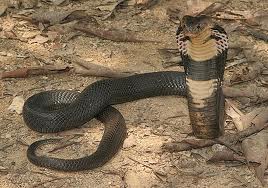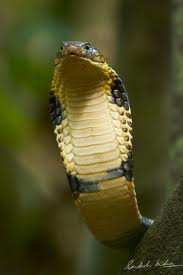Tuesday, June 5, 2012
King Cobra - Reproduction
King Cobra Venom
King Cobra - Venom
Despite not having the most potent venom (it as a lower toxicity than the majority of their relatives, the cobra), it has the ability to inoculate large quantities per bite, making it one of the most deadly snakes. In one bite it can inoculate up to 7 milliliters of its neurotoxic venom, enough to kill 20 people or even an elephant. A bite from this snake will bring in instant pain, blurred vision, vertigo and paralysis. Sometime after, cardiovascular and respiratory system will fail inducing coma and result in death.
Despite not having the most potent venom (it as a lower toxicity than the majority of their relatives, the cobra), it has the ability to inoculate large quantities per bite, making it one of the most deadly snakes. In one bite it can inoculate up to 7 milliliters of its neurotoxic venom, enough to kill 20 people or even an elephant. A bite from this snake will bring in instant pain, blurred vision, vertigo and paralysis. Sometime after, cardiovascular and respiratory system will fail inducing coma and result in death.
The King Cobra
The King Cobra is the longest
venomous snake known. It is considered to be one of the most deadly and
dangerous snakes in Southeast Asia, as well as on the whole planet.
It can reach up to 5.6 m in body length.Found prevalently all over Southeast Asia some regions of the Indian Peninsula, the King Cobra is most commonly found in forest or jungle. The KingC obra is actually not of the Cobra Genus, rather forms it's own particular genus . It is the larger size and neck markings which differentiate the King Cobra from other Cobras. The difference in markings is noted for the arrow shaped markings on the King Cobra's neck area, whereas the markings on other types of Cobra are round in shape and look more like an eye (or sometimes two eyes) It's bite can be deadly to humans, even if only bitten once. The venom is so toxic as to produce a mortality rate somewhere between 33 to 75 percent likelihood of death (depending on how quickly one is treated or if antivenom was administered in time or not). Cases of attacks by King Cobras are rare however, as the King Cobra's nature is shy and tends to avoid confrontations if possible, and normally only attacks if feeling threatened or taken by surprise. It is more likely to recieve a non provoked attack from other species such as the Monocled Cobra, than for the King Cobra to attack without reason
It can reach up to 5.6 m in body length.Found prevalently all over Southeast Asia some regions of the Indian Peninsula, the King Cobra is most commonly found in forest or jungle. The KingC obra is actually not of the Cobra Genus, rather forms it's own particular genus . It is the larger size and neck markings which differentiate the King Cobra from other Cobras. The difference in markings is noted for the arrow shaped markings on the King Cobra's neck area, whereas the markings on other types of Cobra are round in shape and look more like an eye (or sometimes two eyes) It's bite can be deadly to humans, even if only bitten once. The venom is so toxic as to produce a mortality rate somewhere between 33 to 75 percent likelihood of death (depending on how quickly one is treated or if antivenom was administered in time or not). Cases of attacks by King Cobras are rare however, as the King Cobra's nature is shy and tends to avoid confrontations if possible, and normally only attacks if feeling threatened or taken by surprise. It is more likely to recieve a non provoked attack from other species such as the Monocled Cobra, than for the King Cobra to attack without reason
Asian King Cobra
A highly variable species, which is sometimes also known as the monocled
cobra because of the marking on the back of the neck hood that
resembles a pair of spectacles. The upper body colour is usually brown,
ranging from light fawn to almost black. The underside, including the
side of the head is pale yellowish-cream, occasionally with darker bands
or markings. The hood is expanded when the snake feels threatened by
moveable bony extensions of the vertebrae. This, combined with an
extremely loud hiss and the front half of the body raised up off of the
ground, is an imposing sight for any potential predator. The exception
is the mongoose, a small mammal which will readily take on and kill the
cobra.
King Cobra Facts
-
King Cobras are just one type of cobra. Overall, there are hundreds of different types.
-
King Cobras are the only snake in the world that build a nest for their young, just like a bird, but on the ground!
-
King Cobras lay 20-40 eggs in a nest, which is faithfully guarded by female her mate. The incubation time is 60-90 days.
-
King Cobra young are called hatchlings since they come from eggs. Hatchlings are about 50cm long.
-
King Cobras (Ohiophagus hannah) eats other snakes! The Latin word for "snake-eater" is ophiophagus.
-
Cobras are the only snake in the world that can spit their venom, and they are accurate up to about half their own length!
-
King Cobras are the longest venomous snake in the world! The average male grows 18 feet long, and some have been known to grow more than 20 feet long.
-
Cobras are not blind, in fact they see very well even at night.
-
Cobras have a "Jacobsen's Organ" (like most snakes) that gives it super smelling ability. They can sense tiny changes in temperature, which helps them track their prey at night.
-
Cobras typically live to 20 years old or more in the wild.
-
Cobras are at the top of the food chain. Their only natural predators are the mongoose, and man.
-
Cobras venom is not the strongest there is, but cobras can inject so much venom in a single bite that they can kill an elephant. Sea snakes have deadlier venom, and rattlesnakes have weaker venom.
-
Most cobras are shy, and run and hide when people are around. The exception is King Cobras, who are aggressive, and will rear up and stand their ground when confronted.
-
Cobras are not poisonous, they are venomous. This means that even though they have deadly venom in their sacs, the rest of the snake is edible to predators, if they are brave enough to try!
-
Many snake charmers remove the fangs or the venom sacs from their snakes, because it is too dangerous. This practice is illegal, and is considered inhumane to the snake.
-
Cobras eat birds, fish, frogs, toads, lizards, eggs and chicks raided from poultry houses, in addition to small mammals such as rabbits and rats, and even other snakes.
-
Cobras are very intelligent, and can learn quickly, which helps them avoid dangerous areas.
-
King Cobras mainly inhabit Southern Asia, Northern Africa and the Philippines. Other species of cobras roam as far as Australia, New Guinea, and most of the Eastern hemisphere.
-
It is illegal to keep a cobra as a pet in most places, because they are so dangerous.
-
Cobras can hear, although they sense sound through contact with the ground much better than humans.
-
Cobras don't always inject venom when they bite something. They can do a "dry bite" if they want to.
-
Baby cobras have full strength venom and can defend themselves fully like their parents.
-
The male King Cobra stays with the female and her eggs, and takes turns guarding the nest and hunting.
-
A cobras hoods is created by the extension of the ribs behind the snakes' head.
-
Cobras vary in weight from only a few ounces for a typical African Ringhals, to 35 lbs. for a large King.
-
The best special medicine given to cobra bite victims, called "antivenin", is made from cobra venom.
-
Cobras are revered in India and Southeast Asia. The Hindus consider them manifestations of Shiva, the god of destruction and regeneration. The Buddhists believe a massive cobra spread its hood over the Buddha to protect him from the sun while he meditated. Cobra images guard the entrances of many Buddhist and Hindu temples. King Cobras have also been worshipped as sun deities and associated with rain, thunder, and fertility. On the annual lunar holiday of Nag Panchami, Hindus refrain from plowing and field work out of respect for cobras.
Monday, June 4, 2012
India King Cobra
Also
known as the ‘spectacled cobra’ due to spectacle markings on the
hood, the Indian cobra is a prominent species of venomous snake among
reptiles. In a country like India, the cobra is both respected and feared;
it occupies an important place in the Hindu mythology. Indian king cobra can
be seen curled around the neck of Lord Shiva in all the temples dedicated to
the very lord. Vishnu is also depicted reposing on the body of Sheshnag, the
sacred serpent with multiple cobra heads. Even more interesting is the
tradition of cobra-and-mongoose fight that still continues in many parts of
the country. For snake charmers in India, the cobra happens to be the ‘snake
of choice’.
Subscribe to:
Comments (Atom)





















